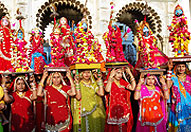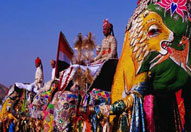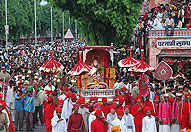Elephant Festival Jaipur
The elephant festival gets underway in the month of Phalgun (March) on the eve of
Holi, the festival of colours. The festival begins with a procession of elephants,
camels, horses and folk dancers. The sight of mighty jumbos striding majestically
is a treat to watch. The mahavats or owners proudly decorate their elephants with
bright colours, jhools (saddle cloth) and heavy jewellery. Female elephants are
made to wear payals or anklets which tinkle as they walk. Prizes are given for the
most beautifully decorated elephant. Even more exciting is the Polo match, the Elephant
race, the tug-of-war between elephant and 19 men and women. The most colourful being
the playing of Holi on Elephant back.
Sheetla Mata Fair Chaksu Jaipur

The Sheetla Mata Fair is held in March-April, the month of Chaitra, in village Seel-Ki-Doongri.
Doongri is a hillock on top of which the shrine of Sheetla Mata stands. The Fair
is held in her honour every year. The fair attracts hordes of visitors from far
and wide. People believe that epidemics spread because of the wrath of Sheetla Mata
and hence they worship her and make offerings so that she may be pacified. The deity
is represented by a red stone. It is veritable picnic for the pilgrims attending
the fair. It is customary to cook one's own food at the site, and eat it only after
it has been offered at the shrine. A temporary market comes up at the fair and the
rural folk can been trading in wares such as shoes, clothes, food stuff, utensils
and agriculture implements. A cattle fair is also organized during the fair. It
is a small affair and lasts for about a week. Bullocks, camels and horses are sold
at the fair and prizes are awarded to the best breeders.
Gangaur Festival Jaipur

The Gangaur festival is the most important local festival of Rajasthan and is observed
throughout the state with great fervour and devotion by womenfolk who worship Gauri,
the consort of lord Shiva. Gan is a synonym for Shiva and Gauri which stands for
Gauri or Parvati who symbolizes saubhagya (Marital Bliss). Gauri is the embodiment
of perfection and conjugal love which is why the unmarried women worship her for
being blessed with good husbands, while married women do so for welfare, health
and long life of their spouses and a happy married life. The festival commences
on the first day of Chaitra, the day following Holi and continues for 18 days. For
a newly-wedded girl, it is binding to observe the full course of 18 days of the
festival that succeeds her marriage. Even unmarried girls fast for the fully period
of 18days and eat only one meal a day. Images of Isar&Gauri are made of clay
for the festival. In some families, permanent wooden images are painted afresh every
year by reputed painters called Matherans on the eve of the festival. A distinct
difference between the idols of Teej and Gangaur is that the idol will have a canopy
during the Teej festival while the Gangaur idol would not a canopy. The ladies decorate
their hands and feet by drawing design with Mehendi (myrtle Paste). The figures
drawn range from the sun, Moon and the stars to simple flowers or geometrical designs.
Teej Festival Jaipur
Teej is the festival of swings. It marks the advent of the monsoon month of Sharvan
(August). The monsoon rains fall on the parched land and the pleasing scent of the
wet soil rises into the air. Swings are hung from trees and decorated with flowers.
Young girls and women dressed in green clothes sing songs in celebration of the
advent of the monsoon. This festival is dedicated to the Goddess Parvati, commemorating
her union with Lord Shiva. Goddess Parvati is worshipped by seekers of conjugal
bliss and happiness. An elaborate procession is taken out in Jaipur for two consecutive
days on the festive occasion which is watched by people in large numbers. The Teej
idol is covered with a canopy whereas the Gangaur idol is open.







